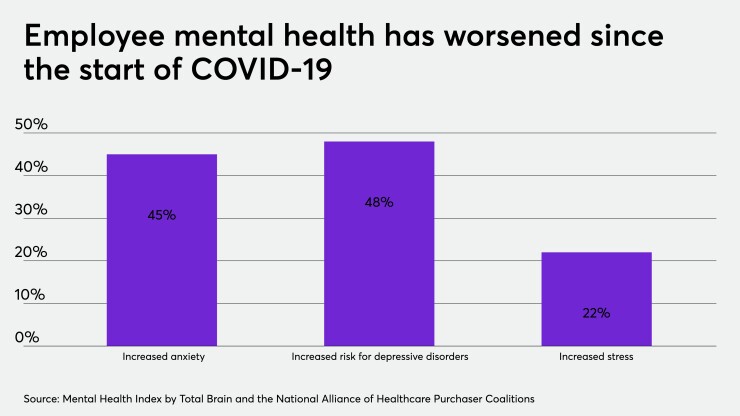Mental health challenges at work have grown increasingly prominent as work-from-home set-ups have diffused workforces and always-on technologies have blurred the line between work and life.
An SAP and Qualtrics study found 60% of employees had symptoms of a mental health condition — and that three out of five said their mental health impacted their productivity. All COVID-19 did was accelerate and expose these problems at a point where it was already long past time to address them.
Read More:
When the pandemic finally ends we cannot simply move on from mental health needs, especially if we assume that a return to normal means a return to something better. We must continue to address problems at their root, in ways that help keep people afloat in the short term and keep them committed in the long term.
Quick fixes for a new reality
A company just cannot be successful with unhappy and unhealthy employees. The events of 2020 shined an even brighter light on this reality, forcing companies to think in an agile way about how they could best support their teams amidst unimaginable upheaval.
Read More:
Some areas where businesses focused their energy included:
- Flexible work: Despite being the most-discussed work-related trend of the pandemic, few likely know the real WFH numbers. According to Pew, 71% percent of people whose jobs could be done from home went remote last year. Fifty-four percent want to keep it that way. So, yes, the trend is real. However, six out of 10 workers told Pew their jobs could not be done from home. That means, for many companies, there was more to take into account.
- Crisis leave: Many companies, including SAP, created space for crisis leave so employees could focus on health and wellbeing issues directly related to the pandemic — whether it be healthcare, child care or self-care. Still, there’s a distinct difference between crisis leave and a real vacation.
- Paid time off: Workers in 2020 were more hesitant to use PTO than ever. This left companies trapped between a rock and a hard place. At SAP alone, we saw 325,000 fewer vacation days used than in 2019. It was never more important to urge employees to unplug so they could rest and recharge.
We’re continuing to examine ways to make a real difference in our employees’ lives at SAP, as vaccine rollout begins to ramp up around the country. For instance, we recently announced SAP Mental Health Day, an additional, fully-paid day off for all SAP employees on April 27. We know one day isn’t enough, but we hope it’s a step in the right direction that employees internalize and embrace in other ways as the year rolls on.
Read More:
Most importantly, we hope that this day helps us all recognize the importance of mental health and wellness and destigmatizes mental illness — particularly in the workplace.
Building long-term changes
All of the changes made by companies in 2020 are important. But short-term fixes are easy. Any company can add a PTO day here or a remote work day there. The changes necessary to advance us forward in 2021 and beyond are deeper. They are structural, institutional and foundational.
As the threat of COVID-19 hopefully recedes, employee situations will become even more varied. Some will be remote, some will be in the office, some will live out a combination of both. Some will try to return to the way things were, and some will never even have that chance. Companies must work to personalize employee experiences in a more focused way than ever before. We need to learn what they need, and we need to help them get it. It’s not that complicated, really. Employees give us value. We give them care and we do this by listening to what they tell us.
If there’s one thing we learned in 2020, it’s the importance of listening to people when they speak out about an issue. From COVID’s outset in the spring to the peak of racial justice protests in the summer, it was clear that engaging with people on the terms of their experience was essential. By taking into account the structural and institutional inequities that exist, businesses can better respond and better serve employees, constantly and consistently.
Enabling full and complicated lives
As a lifelong baseball fan and an HR leader, one particularWall Street Journal headline about the Kansas City Royals last June jumped out to me in its simplicity. “Baseball’s Newest Market Inefficiency,” it said, “Treating People Like People.” Ultimately, that’s all any of this comes down to. Fulfilling work is grounded in a fulfilling life. Yet it seems, still, that too many companies just don’t get that.
Too many companies treat employees like numbers in a spreadsheet, like line items in a budget. We must learn to treat each and every one in the way they’re meant to be treated — like people. Because that’s how you build a healthy work culture that’s truly built to last.
Just think of the question the last year has asked us over and over again, in every facet of our lives: Do you truly care about the person standing next to you? Then prove it.






